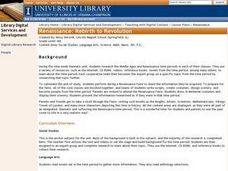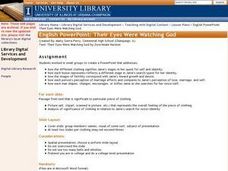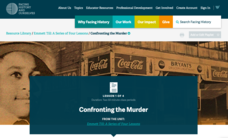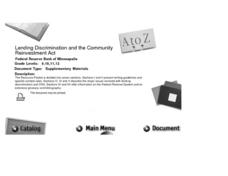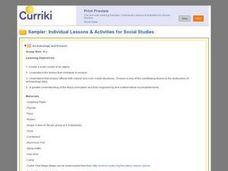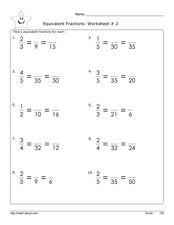Curated OER
"What Was Rome"
Eighth graders study the richness, diversity and significance of Roman Civilization. They demonstrate in what ways Rome has influenced subsequent civilizations and what is meant by the "Fall of the Roman Empire". They clarify that...
Curated OER
Medieval Europe: Feudalism
Eighth graders study European society during the medieval period. They investigate the feudal social structure and how it influenced daily life. They study Japanese society during the medieval period. They compare and contrast the...
Curated OER
The Renaissance: How did it change the world?
Eighth graders identify the conditions in Medieval Europe that contributed to the beginning of the Renaissance. They find characteristics of the Renaissance in its art, economy, discoveries, and ideas. They examine the ideas of Humanism...
Curated OER
Renaissance: Rebirth to Revolution
Sixth graders use a variety of resources to research the Middle Ages and Renaissance over a nine-week period. Working in cooperative teams, they become experts on specific topics. Students hold a Renaissance Faire and role-play as...
Curated OER
English PowerPoint: Their Eyes Were Watching God
Students read, "Their Eyes Were Watching God," by Zora Neale Hurston. They explore the use of symbolism that depicts the main character's quest for self knowledge and identity. After identifying the significance of clothing in relation...
Curated OER
Discovering Rhythm and Rhyme
Students explore ways to provide enjoyable phonemic awareness and conversation experiences for their children while reading and discussing children's book, A Tree For Me. Students extend their expertise in reading by fluently reading...
Curated OER
Matching Games, Trees and Animals
Students identify and define new words as they are introduced to specific trees, leaves, animals and animal habitats, engage in literacy-related play by playing games that focus on animals and trees mentioned in book, A Tree for Me, and...
Curated OER
Scavenger Hunt
Students and their families participate in nature walk to locate, observe, and identify scavenger hunt items as well as other items of interest, compare and discuss finds with each other, and identify items found that do not belong in...
Facing History and Ourselves
Emmett Till: Confronting the Murder
The 1955 murder of Emmett Till is often regarded as the catalyst for the Civil Rights Movement of the 20th century. Learn more about the brutal crime—and, as many believe, the miscarriage of justice—that began a national conversation...
Curated OER
My Money
Learners identify and interpret the relationships between various components of currency, discusses the uses of money, and provides advanced lessons on making change. They also identify the various ways that money is used and how to use...
Curated OER
Economic Activity and Markets
High schoolers identify and interpret that economic activity involves making choices in the face of scarcity, therefore making choices involves a cost. They also identify that individuals interact in markets by inducing one another,...
Curated OER
Lending Discrimination and the Community Reinvestment Act
Write about economic and banking issues of concern to the public. Investigate lending discrimination and the impact of the 1977 Community Reinvestment Act. Use a guide to do research and write an essay.
Curated OER
Fraction One-Half
In this recognizing the fraction 1/2 worksheet, students observe blank bars and fill them in showing different ways to make one-half. Students answer eight questions.
Curated OER
Simulating a Middle East Peace Summit
Tenth graders explore the issues in the Middle East. In this World History lesson, 10th graders research the problems between Palestine and Israel. Students write a speech on their point of view of the peace process.
Curated OER
You are the Curator: Building a Museum of the 1920s and 1930s
Learners examine primary and secondary sources regarding 1920's and 1930's America. In this Webquest lesson, students explore sources regarding the American decades in order to create their own museum exhibits.
Curated OER
Archaeology and Erosion
Sixth graders study how erosion affects archaeology sites. In this investigative lesson, 6th graders construct a model of a pyramid using sugar cubes. They will investigate in groups how water, wind, and sunlight affects their model...
Curated OER
Simplify Fractions
In this reducing fractions worksheet, students find the common factors to reduce fractions to their lowest terms. Students solve 12 problems.
Curated OER
Simplify the Fractions
In this reducing fractions to their lowest terms worksheet, students find the common factors, identify the largest common factors, and simplify the fractions.. Students solve 12 problems.
Curated OER
Equivalent Fractions: # 2
In this finding equal values of fractions worksheet, students read fractions plus a pair of fractions with only the denominators and fill in the numerators making each problem equivalent. Students solve 20 problems.
Curated OER
Division facts: no remainders
In this division worksheet, students divide two digit numbers by one digit numbers without remainders. Students complete 12 division problems.
Curated OER
Two-Digit Addition
In this finding the sums worksheet, students use a number line to add two-digit numbers without regrouping. Students solve 20 problems.
Curated OER
Site and Situation: Right Place at the Right Time
Students analyze geographic details. In this research skills lesson, students research maps as well as primary and secondary sources to analyze growth, population, and manufacturing in Altoona, Pennsylvania following World War II....
Curated OER
Ancient Egypt Alphabet Book
Young scholars research Ancient Egypt using a specific letter of the alphabet as a guide. In this Ancient Egypt lesson, students independently research their assigned topic using ProQuest or other research software. Once young scholars...
Facing History and Ourselves
Who Am I?
Sixth graders explore how people throughout time have responded to questions regarding identity. For this The House on Mango Street lesson, 6th graders create an identity chart for a fictional character and then write personal essays...





